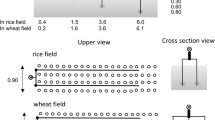Summary
A four year study examined the effect of irrigating at various water deficits at different times in the growing season, in combination with a range of nitrogen fertilizer rates, on the growth, yield and quality of cotton. The major effect of irrigation treatment on growth was to increase leaf area and plant size; net assimilation rate in the vegetative phase was not affected by irrigation treatment. The initial rate of boll setting was slightly faster in low nitrogen and less frequent irrigation treatments, but by day 180 (immediately prior to defoliation), all treatments had 60% of total dry weight as bolls and 7% as leaf. The best irrigation strategy varied from year to year due to the variable rainfall pattern. Irrigation when 80% of the available soil moisture had been depleted in the first half of the season only decreased total lint yield by up to 12% in two of the four seasons. During the second half of the season the 80% level of depletion decreased yield by an average of 15% but gave an earlier crop. Yield was reduced by up to 17% if irrigation at 40–60% of available moisture depletion in the first half of the season was followed by irrigation at 80% of available moisture depletion in the second half of the season. A rainfed treatment yielded from 16 to 43% less than the heaviest yielding irrigation treatment. After irrigation there was evidence of poor aeration in the soil which was most severe and lasted the longest at 30 cm depth. Heaviest yields were obtained with 100–150 kgN ha−1, except in rainfed treatments where 0–50 kgN ha−1 was sufficient. Irrigation at only 40% of available moisture depletion decreased nitrogen uptake in all seasons. Treatment effects on fibre quality in these experiments were small and variable. Nitrogen fertilizer generally increased length and strength but decreased micronaire. Stress during boll filling decreased micronaire and length in two of the four seasons.
Similar content being viewed by others
References
Birkle DE, Letey J, Stolzy LH, Syuszkiewicz TE (1964) Measurement of oxygen diffusion rates with the platinum microelectrode. I. Factors influencing the measurement. Hilgardia 35:555
Constable GA, Gleeson AC (1977) Growth and distribution of dry matter in cotton (Gossypium hirsutum L.) Aust J Agric Res 28:249
Constable GA, Hearn AB (1978) Agronomic and physiological responses of soybean and sorghum crops to water deficits. I. Growth, development and yield. Aust J Plant Physiol 5:159
Constable GA, Hearn AB (1980) Irrigation for crops in a sub humid environment. I. The effect of irrigation on the growth and yield of soybeans. Irrig Sci 2:1
Cull PO (1979) Irrigation scheduling of cotton by computer. Ph. D. Thesis University of New England Armidale, N.S.W. Australia
Cull PO, Hearn AB, Smith RCG (1981) Irrigation scheduling of cotton in a climate with uncertain rainfall. I. Crop water requirements and response to irrigation. Irrig Sci 2:127
Hearn AB (1969) The growth and performance of cotton in a desert environment. II. Dry matter production. J Agric Sci 73:75
Hearn AB (1975) Response of cotton to water and nitrogen in a tropical environment. I. Frequency of watering and method of application of nitrogen. J Agric Sci 84:407
Hearn AB (1979) Water relations in cotton. Outlook Agric 10:159–66
Hearn AB (1976) Response of cotton to nitrogen and water in a tropical environment. III. Fibre quality. J Agric Sci 86:257
Hearn AE, Constable GA (1981) Irrigation for crops in a sub-humid environment. V. Stress day analysis for soybeans and an economic evaluation of strategies. Irrig Sci 3:1
Hesketh JD, Low A (1968) Effect of temperature on components of yield and fibre quality of cotton varieties of diverse origins. Cotton Grow Rev 45:243
Letey J, Stolzy LH (1964) Measurement of oxygen diffusion rates with the platinum microelectrode. I. Theory and equipment. Hilgardia 35:545
Mason WK, Smith RCG (1981) Irrigation for crops in a sub-humid environment. 111. An irrigation scheduling model of soybeans for prediction of water use and crop yield. Irrig Sci 2:89
McIntyre DS (1970) The platinum micro-electrode method for soil aeration measurement. Adv Agron 22:235
Ritchie JT (1972) Model for predicting evaporation from a row crop with incomplete cover. Water Resour Res 8:1204
Stolzy LH, Letey J (1964) Measurement of oxygen diffusion rates with the platinum microelectrode. III. Correlation of plant response to soil oxygen diffusion rates. Hilgardia 35:567
Williams CH, Twine JR (1967) Determination of nitrogen sulphur phosphorus potassium sodium calcium and magnesium in plant material by automatic analysis. CSIRO Aust. Div Plant Industry Tech Paper 24
Author information
Authors and Affiliations
Rights and permissions
About this article
Cite this article
Constable, G.A., Hearn, A.B. Irrigation for crops in a sub-humid environment. Irrig Sci 3, 17–28 (1981). https://doi.org/10.1007/BF00251380
Received:
Issue Date:
DOI: https://doi.org/10.1007/BF00251380




